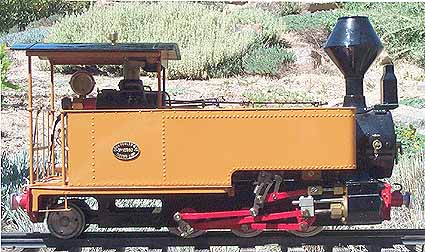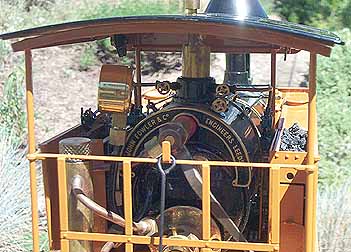
Back to Sidestreet Bannerworks
August 2003
Brandbright/Roundhouse Fiji
by Marc Horovitz

The firm of John Fowler & Co., of Leeds, England, perhaps best known for its steam plowing engines, also made some of the most attractive industrial locomotives in the world. These were supplied to many countries for many purposes. Several went to places like Australia, Fiji, and Argentina to work on sugar plantations hauling cane.
Nº 10992 was a 2'-gauge engine, built in 1907 for Labasa Mill in Fiji, and working as that company's Nº 3. It was the first 0-6-2 in use in the area and was followed by nine more. These locomotives worked variously with no tender, a four-wheel tender, or an eight wheel, bogie tender. A sister engine, Nº 4, suffered a boiler explosion in 1913, killing two men and injuring two others.
As with most locomotives that enjoyed a long working life, these 0-6-2s were rebuilt several times over the years, resulting in changes in detail and appearance. The model discussed here is of the engine as it left Fowler's works in 1907. The locomotive was finally retired in 1964 and exists today, preserved at Labasa Mill with a four-wheel tender from engine Nº 5.
The model
Roundhouse Engineering brought out its Fowler 0-6-2 tender engine, upon which this one is based, in 1988. The engine is well made but has Roundhouse's usual low level of detail from that era. Richard Longley, of Brandbright Ltd., wanted to offer a similar engine with a much higher level of detail and chose Fowler's Nº 10992. Mechanically, the engine is similar to a standard Roundhouse product. The bodywork, though, is more finely crafted and contains much more detail than normally found on Roundhouse engines. This detail includes complete (nonfunctional) sanding gear, piping, valves, builders plates, and more.
The engine burns butane gas. A gas tank is concealed in the left side tank and is accessed through a removable hatch. The gas-control valve is disguised as a brake staff in the cab. A reversing lever is placed on the left side of the cab. The interesting, semi-circular Fowler nameplate appears across the top of the backhead. While the prototype had Joy valve gear, the model has Roundhouse's usual abbreviated Walschaerts gear. My model is 45mm gauge, which is incorrect for a 2'-gauge engine in 16mm scale. It should have been 32mm, which was also offered.
The run
As with many engines featured here, this one had not been run in over a decade, so the run was approached with some trepidation. The safety valve is housed beneath a cover in the cab that has vents that exhaust through the cab roof. This cover is attached to the safety valve with a set screw, the idea being that you need only turn the cover to remove the safety valve for filling. I tried this, only to find that the valve had solidly glued itself to its boiler bushing. I took off the cover and ultimately had to resort to pliers to remove the safety valve, marking it in the process. This was not an auspicious beginning.
With the boiler filled and the safety valve and cover restored to its former position, I filled the lubricator and gas tank and oiled all around. I opened the gas a crack and lit the fire at the smokestack. It caught instantly, burning in the flue with a low roar. After five minutes or so, the pressure had risen to 40 psi. I shut off the gas and topped up the fuel. Then I relit the fire and opened the throttle. (Most of the Fiji models produced were radio controlled, but I ordered mine for manual control.) After some initial lurching, the engine moved smoothly off. It traversed the railway at a slow and steady speed for lap after lap, providing just the sort of run we've come to expect from Roundhouse locomotives with the added treat of all the additional detail on this unusual engine.
.
|
|
|
| Builder | Brandbright Ltd and Roundhouse Engineering (England) |
| Date built | 1991 |
| Gauge | Nº 1 (45mm) |
| Scale | 16mm = 1' |
| Boiler | Single flue |
| Fittings | Throttle, safety valve, level plug, pressure gauge |
| Fuel | Butane |
| Blow-off pressure | 40 psi |
| Cylinders | Two, double-acting D-valve |
| Reversing gear | Modified Walschaerts |
| Lubricator | Displacement |
| Dimensions | 10-1/2" long, 4-5/8" wide, 7" tall |





Above right: The backhead, with its distinctive plate around the top of the boiler. The plate reads, "John Fowler & Co. Engineers Leeds.” The throttle is at the top of the backhead in the center. The valves around the steam dome are dummies.
Right: The cab roof, lined with wood, raises for access to the controls.
.

Far right: The safety-valve cover vents steam through the cab roof.



Right: Some of the detail included in this model is the fully equipped sanding gear. On the prototype, the rods, controlled from the cab, turn the valves on the various sand boxes mounted between the tanks and the boiler.
.
.
.

Back to Sidestreet Bannerworks home page
This page and its contents
Copyright Sidestreet Bannerworks, 2003